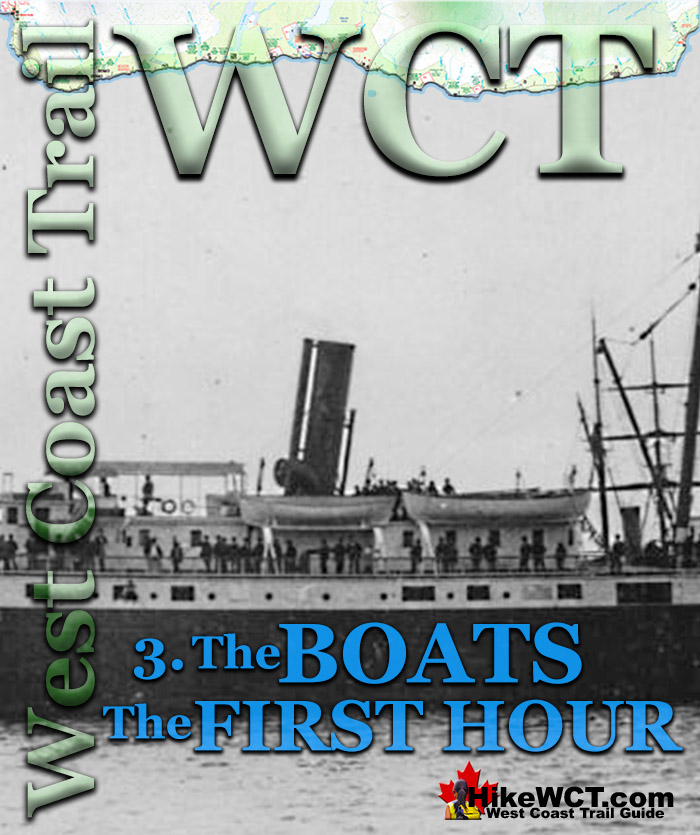![]() The Valencia was equipped with six lifeboats and a smaller working boat. These seven boats could hold up to 181 people. Just enough to accommodate the estimated 178 crew and passengers aboard. There were also three life rafts on board which could reportedly hold up to 44 people, though one slid off the ship and was lost.
The Valencia was equipped with six lifeboats and a smaller working boat. These seven boats could hold up to 181 people. Just enough to accommodate the estimated 178 crew and passengers aboard. There were also three life rafts on board which could reportedly hold up to 44 people, though one slid off the ship and was lost.
The Valencia Disaster
![]() 1. The Valencia
1. The Valencia ![]() 2. The Voyage
2. The Voyage ![]() 3. The Boats
3. The Boats ![]() 4. The McCarthy Boat
4. The McCarthy Boat ![]() 5. The Bunker Party
5. The Bunker Party ![]() 6. On the Valencia
6. On the Valencia ![]() 7. The Rafts
7. The Rafts ![]() 8. The Turret Raft
8. The Turret Raft ![]() 9. The Rescue Ships
9. The Rescue Ships ![]() 10. The Aftermath
10. The Aftermath ![]() 11. The Survivors
11. The Survivors ![]() 12. The Lost
12. The Lost
The West Coast Trail
![]() Prologue
Prologue ![]() 1: The West Coast Trail
1: The West Coast Trail ![]() 2: When to Hike & Fees
2: When to Hike & Fees ![]() 3: Trailheads
3: Trailheads ![]() 4: Getting There
4: Getting There ![]() 5: Considerations
5: Considerations ![]() 6: Campsites
6: Campsites ![]() 7: Shipwrecks
7: Shipwrecks ![]() 8: Routes
8: Routes ![]() 9: Sights & Highlights
9: Sights & Highlights
Captain Johnson was quick to act after the initial collision and ordered the engines in full reverse in an attempt to back the crippled ship onto the shore which was now thought to be close behind the ship. Moments later the ship collided with a rock shelf and held in that position. Frank Lehn, freight clerk on the Valencia vividly described what happened in an interview that appeared in the Victoria Daily Colonist on January 27th, 1906. “When the ship first struck there was wild excitement. The screams of men, women and children mingled in awful chorus with the shriek of the wind, the dash of the rain and the roar of the breakers. It was pandemonium. The shouts of the officers could hardly be heard and the rush of the passengers as they ran hither and thither created confusion which for a time seemed uncontrollable. Women came from their staterooms half clad, dragging children by the hands or clasping babies to their breasts; men clad only in their night attire sprang from their births and rushed to the boats, only to be beaten back by the officers and sailors, who were doing their best to restore order and control of the 140 odd people. Children became lost from their mothers; wives lost track of their husbands; all ran here and there, seeking for each other and for safety. God only knows how many were swept away as soon as they reached the deck. Great seas broke over the ship as soon as she struck the second time, and when she drifted back on the reef stern on, the seas raked her from fore to aft, carrying everything before them. Never have I seen such waves. They appeared to be as high as the masthead. One after another in rapid succession they rolled over us and people were carried away in bunches. Their agonized shrieks could be heard above all the fiendish roar of the wind and sea.”
Valencia's Final Route to Disaster

The First Hour of the Valencia Disaster
Moments after the Valencia backed onto the reef the captain then ordered the lifeboats lowered to the saloon rail in preparation for launching. It appears that during the first hour of the wreck that six of the seven lifeboats were launched quickly, not properly manned by crew and not even properly filled. Two or three of the boats had one end fall due to snapped or cut ropes, throwing dozens into the sea to drown and smashing the boats against the ship. Nearly all the witnesses later testified that the captain never ordered the boats lowered and most simply recalled that someone ordered the boats lowered. What we know for sure is that the boats were lowered very quickly after the wreck. Many of the crew were assigned specific boats to take charge of and some found their boats already dropped. There are quite a few survivors that each saw a glimpse of the boats being launched during this first horrific hour and combined they produce a pretty good, though vague picture of what happened.
Location of Valencia's Lifeboats
The Valencia's six lifeboats were located three on each side. The No.1, No.3 and No.5 were on the starboard side or right side of the ship if facing forward. The port side, or left side had the No.2, No.4 and No.6 lifeboats. The Valencia in the picture here, shows the No.2, No.4 and No.6 lifeboats clearly on the port side. No.1, No.3 and No.5 are not quite visible on the starboard side. Boat No.7, was a smaller working boat and it was located further back on the ship behind the No.6 and No.5 lifeboats. The forward four lifeboats, No.1, No.2, No.3 and No.4 were located on the fiddlers deck. Below the fiddlers deck were the forward cabins and to the left of the cabins was the chart house, then the bridge and furthest left in the picture below was the pilot house. The No.5 and No.6 lifeboats were on top of the after house of the hurricane deck. The three life rafts were also on the hurricane deck.
The Valencia's Port Side Lifeboats
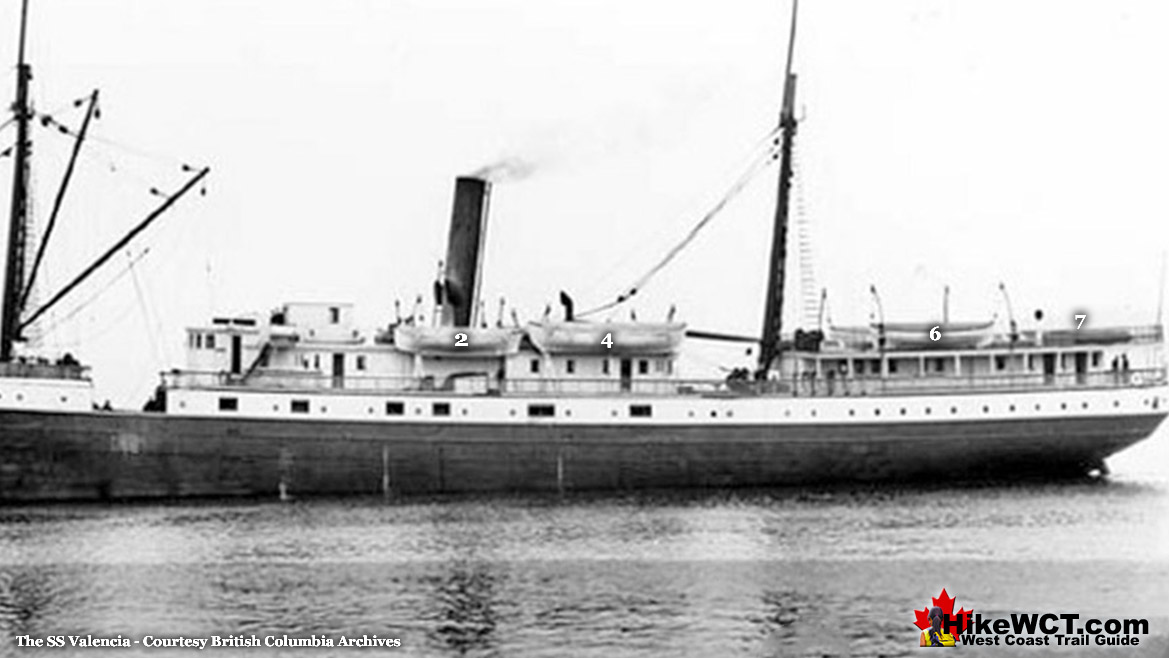
Lifeboat No.4 Smashed, No Survivors
From various fragments of eyewitness reports, it appears that the No.4 boat was the first of six boats lowered in the first chaotic minutes of the wreck. Freight clerk Frank Lehn gave a horrifically vivid account of the No.4 boat, which he refers to as the port amidships boat. “When order was somewhat restored, Captain Johnson gave the order to get out the port amidships boat. The men worked with a will and risked their lives a dozen times over in the effort to get the craft launched. They would cling to their ropes while a great wave swept over the wreck, and as soon as the water subsided would get to work on the craft again. As soon as it was free from the ship and hanging in the davits a great breaker smashed her to kindling wood and carried away some of the sailors who were handling the craft.”
Other Valencia survivors remember glimpses of boat No.4. Sam Hancock, the chief cook on the Valencia was just going to bed on the night of the wreck. Just before midnight he heard the ship strike and quickly got out of bed and dressed. Five minutes later the Valencia stuck again. He heard the call for all hands on deck and rushed to his station at boat No.4 which was being lowered. He attempted to climb down into it and looked down to see it slammed into the side of the ship and smashed, drowning all on board. Max Stensler, a fireman on the Valencia remembered helping to lower the No.4 lifeboat to the saloon deck, where Captain Johnson had ordered it fastened. He believed that someone had cut the ropes causing the boat to fall into the water and smash against the ship. Passenger George Harraden saw the ropes break on one lifeboat that was likely the No.4.
Lifeboat No.7 Smashed, Only Carrick Survived
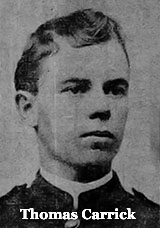 It appears likely that lifeboat No.7 was the second boat to be launched during the first horrific hour of the Valencia disaster. The No.7 was the small working boat located the furthest back on the ship and launched on the starboard side. With the Valencia’s bow facing out to sea, the starboard side was the right side of the ship which faced northwest, up the coast of Vancouver Island. Valencia’s first assistant engineer, Thomas Carrick gave a graphic account, printed in the San Francisco Call newspaper, of the events after the ship backed onto what was believed to be the mainland United States. “The ship sank rapidly and about ten minutes after she struck gave way as if her back had broken, and listed heavily. Three waves struck her and threw her back on a level keel, and she rested in that way until the end, seeming to be pinned among the rocks. I was in charge of boat No.7, the second one launched. Besides myself, there were seven men in the boat, five of the crew and two passengers. The lines were fouled and someone tried to cut us away, but only after the line parted and the boat plunged forward and telescoped alongside the ship. Everyone was thrown out and a number were crushed to death between the boat and the ship.”
It appears likely that lifeboat No.7 was the second boat to be launched during the first horrific hour of the Valencia disaster. The No.7 was the small working boat located the furthest back on the ship and launched on the starboard side. With the Valencia’s bow facing out to sea, the starboard side was the right side of the ship which faced northwest, up the coast of Vancouver Island. Valencia’s first assistant engineer, Thomas Carrick gave a graphic account, printed in the San Francisco Call newspaper, of the events after the ship backed onto what was believed to be the mainland United States. “The ship sank rapidly and about ten minutes after she struck gave way as if her back had broken, and listed heavily. Three waves struck her and threw her back on a level keel, and she rested in that way until the end, seeming to be pinned among the rocks. I was in charge of boat No.7, the second one launched. Besides myself, there were seven men in the boat, five of the crew and two passengers. The lines were fouled and someone tried to cut us away, but only after the line parted and the boat plunged forward and telescoped alongside the ship. Everyone was thrown out and a number were crushed to death between the boat and the ship.”
In another interview Carrick recalled, “She turned turtle and a powerful wave hurled the overturned boat against the Valencia’s side with terrific force.” He describes how one crewman on board, “was struck by the gunwale of the lifeboat, jammed against the ship’s side, and, with broken neck, staring, glassy eyed he sank into the maw of the growling sea. This frightful calamity happened under the eyes of all on board. With whitened faces all stood frozen with fear. I was in the that boat, and when I felt myself swallowed by the sea I cried to God in by misery. It seemed ages while I was being hurled and crashed about by the huge breakers. Lines were thrown to those in the water, but in the darkness we could not see them. I was in the water about fifteen minutes when I caught a line and got my leg around the block and was hauled aboard.” The identities of the other people on the boat seem to be unknown, though in another interview, Carrick mentions that there were, “two seamen, three firemen, an oiler and a couple of passengers.”
Another witness to the disastrous launching of boat No.7 was boatswain Timothy McCarthy. “No.7 was a wrecking boat and was small. She was in charge of Assistant Engineer Carrick. As she was lowered, one end became unfastened, and the people in her were spilled into the sea, all losing their lives except Carrick, who was pulled on board by his shipmates.” A.H. Hawkins, a passenger on the Valencia saw the No.7 boat launched and declared that, “the small working boat was dropped into the water on account of the breaking of the tackle.” James Willits, a passenger who would escape the shipwreck on the Topeka Raft recalled in one sentence the disastrous launching of the No.7 and No.1 lifeboats. “Two of them on the weather side were launched and were smashed like eggshells as soon as they struck the water.”
Freight clerk Frank Lehn, in an interview referred to the second lifeboat launched as the “port quarter boat”, which was the No.6 boat, which we know from other accounts was launched successfully. Lehn must have meant the No.7 boat, the working boat, located just behind the starboard quarter boat, the No.5 which was launched the following morning. The No.7 is likely the one he saw and described as repeating the same performance as the No.7 and was “crushed against the vessel’s side, breaking like and eggshell.”
Comparing all witness accounts of boat No.7, it appears that as the boat was being lowered, or at least prepared to be lowered, the ropes at one end slipped through the tackle and the boat dropped at one end. People were thrown into the water, however it may be that some remained, as the tackle at the other end was quickly cut to free the boat. This may have been done in a panic to save the people hanging on in the dangling boat, if there were any. Or to release the boat for any survivors in the water to attempt to get on. This all would have happened in darkness, so cutting the tangled ropes to free the boat may have been simply a reflexive act done in an instant. Carrick was the only survivor from lifeboat No.7.
Lifeboat No.1 Overloaded, Cockbilled Two Rescued.
Timothy McCarthy, boatswain on the Valencia recalled the third boat launched, the No.1 boat, “…was at once filled to overflowing with screaming, maddened people, and when the davits broke because of the great weight, they were spilled into the sea, and lost before our eyes.” Martin Tarpey, quartermaster on the Valencia and was in charge of boat No.1, recalled, “After 25 or 30 people entered, overloading her. Something carried away and all were thrown into the sea.”
George Harraden, a first class passenger on the Valencia that escaped on the raft picked up by the Topeka recalled sending his mother off on what was likely the No.1 boats. He was asleep at the time of the accident, having retired about 9pm. He had spoken to the first officer earlier, who told him that they expected to get to Victoria about 3am. When he came out to the deck he heard someone say “Lower the boats to the saloon rail.” He then went and found his mother in the social hall. He then heard someone call the ladies out to get in the boats. He told his mother to go and get in, which she did, and it was the last he saw of her. He did not know if she went from the port or starboard side. He saw one of them capsize, and it appeared to him that she gave way at one end and turned completely over. There were lines thrown over to try to rescue the passengers, but he could not say if any were brought back.”
Another witness to the launching of the No.1 boat was fireman John Segalos, “The Officers and crew passed out life belts to everybody and orders were given to man the boats. Ah! It was terrible, the darkness, the rain, the crashing of the wreck, the roar of the boiling surf that swept from end to end of the vessel. Panic seized many, there was a blind rush in the black fog to get to the boats. At about 12:30 I saw a boat loaded with 25 people crash from the davits and everyone fall into the sea.”
Lifeboat No.2 Launched and Disappeared.
Valencia’s mysterious No.2 lifeboat appears to be the fourth launched in the first hour of the wreck. Little is known and few survivors remember anything beyond that it was successfully launched and it was heading away from the ship. Witnesses report the Valencia’s searchlight was trained on it for a few moments until the generator stopped and the light went out. First assistant engineer  Thomas Carrick, who survived on the Topeka Raft reportedly witnessed boat No.2 depart the Valencia with 18 to 20 people on board. He recalled that purser J.J. O’Farrell was in charge, with third officer James Cameron assisting him. Another witness who saw it depart was first assistant freight clerk Frank Lehn. He recalled it leaving with a strong crew and at least six women on board. Of the crewmen on board, he could only recall the names of O’Farrell and Cameron. He could not name any of the women on board. Valencia’s boat No.2 was not located in the days after the disaster and no survivors were ever found.
Thomas Carrick, who survived on the Topeka Raft reportedly witnessed boat No.2 depart the Valencia with 18 to 20 people on board. He recalled that purser J.J. O’Farrell was in charge, with third officer James Cameron assisting him. Another witness who saw it depart was first assistant freight clerk Frank Lehn. He recalled it leaving with a strong crew and at least six women on board. Of the crewmen on board, he could only recall the names of O’Farrell and Cameron. He could not name any of the women on board. Valencia’s boat No.2 was not located in the days after the disaster and no survivors were ever found.
The boat became a bit of a mystery as it appears to be the only boat successfully launched that first hour that was adequately crewed, yet it was lost. The other two boats that managed some distance from the ship were manned by passengers and crew members who didn’t seem to know what they were doing. Despite this, two survived one boat and seven survived the other. The well crewed No.2 seemed to have the best chance of success, yet apparently failed completely. One helpful clue to the mystery would have been the recovery the bodies of O’Farrell or Cameron, but neither were ever found, or at least identified. It appeared that mystery would never be solved and it was assumed that it flipped over in the surf and everyone drowned.
“Eight Victims of Valencia Wreck Are Found”
 On August 23rd, 1906, seven months after the Valencia disaster, the San Francisco Call newspaper ran a story with this alarming headline. “SKELETONS RECALL DREAD TRAGEDY – Bones of Eight Victims of Valencia Wreck Are Found Near Lifeboat – STARVED TO DEATH” The article then went in graphic detail. “Eight skeletons lying beside a lifeboat in a cave near Carmanah, on the west side of Vancouver Island, dumbly tell what is undoubtedly the most terrible tragedy of last January’s wreck when the liner Valencia pounded to pieces on the treacherous coast of Vancouver Island. A special from Carmanah this afternoon reporting the heart breaking discovery says the boat’s crew had made apparent safety and starved to death because the coastline was no adequately searched. It will be impossible to identify the remains of the eight victims.”
On August 23rd, 1906, seven months after the Valencia disaster, the San Francisco Call newspaper ran a story with this alarming headline. “SKELETONS RECALL DREAD TRAGEDY – Bones of Eight Victims of Valencia Wreck Are Found Near Lifeboat – STARVED TO DEATH” The article then went in graphic detail. “Eight skeletons lying beside a lifeboat in a cave near Carmanah, on the west side of Vancouver Island, dumbly tell what is undoubtedly the most terrible tragedy of last January’s wreck when the liner Valencia pounded to pieces on the treacherous coast of Vancouver Island. A special from Carmanah this afternoon reporting the heart breaking discovery says the boat’s crew had made apparent safety and starved to death because the coastline was no adequately searched. It will be impossible to identify the remains of the eight victims.”
The article goes on to quote Phil Daykin, the Carmanah Point Lightkeeper. “If the men got into the cave alive, as it is evident, they did, they must have starved to death. It is a veritable mantrap. There is a large rock at the mouth of the cave, over which the boat must have been hurled by huge waves, as there is not enough room on either side of the rock to get the boat out again when the water is smooth. The boat’s crew must have perished before the storm subsided. The boat is all right except for a small hole in the forward air chamber near the gunwale.”
“The missing No.2 boat of the ill-fated steamer Valencia”
A few days later the Victoria Daily Colonist reported. “The finding of a boat with eight skeletons of victims of the storm’s wrath, probably from the lost Valencia, in a cave on the island coast.” A local First Nations man made the discovery while cruising along the coast in his canoe. He found a huge cave, he estimated to be about 55 feet wide at its opening, which was blocked by an enormous rock. Unable to maneuver his canoe up over the steep and slippery rock, he entered the cave without it. Inside the cave he had to swim through deep water before the cave sloped upward and he emerged from the water and continued on foot. The cave was strewn with shipwreck debris and about 200 feet from the entrance he came to a large lifeboat that looked to be in surprisingly good condition. As he got closer and looking inside the boat he was shocked to find eight skeletons of people long dead.
News of the discovery reached Phil Daykin, the Lightkeeper at the Carmanah Point Lighthouse. He sent two of his sons to investigate and the Daily Colonist reported, “They found things as had been described by the Indian. The boat had obviously been carried over the entrance rock by the sea-swell and drove into the flotsam which piled up at the cave end. There were eight corpses decomposed beyond all identification, with but the bones left. There was also an iron safe, and a pontoon. The debris in the cave was well piled up, but it could be seen that the boat, though pinioned by the wreckage, was practically undamaged.” The Daily Colonist article went on to suggest an investigation should take place and that it, “would seem to indicate more than ever that the boat is the missing No.2 boat of the ill-fated steamer Valencia, lost in that vicinity last January, with 140 lives. This boat was last seen when leaving the wreck, located not far from Pachena Point. Many witnesses told at the inquiry regarding the Valencia disaster about the departure of this boat, but its fate was never cleared up.”
“CAVES WHICH HELD VALENCIA WRECKAGE”
A couple days later, on September 1st, 1906, the Victoria Daily Colonist ran another story titled, “CAVES WHICH HELD VALENCIA WRECKAGE” The article describes the investigation underway by local agent, Capt. Gaudin, which had expanded to include another cave where a life raft was reportedly found as well. It is interesting to note that the investigation didn’t include going to the caves, but rather just picking up a report from Lightkeeper Daykin on the investigations done by his sons. This article goes on to contradict details reported in the previous article printed on August 29th. The previous article stated that the Daykin’s saw the lifeboat and eight corpses, as well as describing the scene as though it was newly witnessed by the Daykin’s. This new article reports that the Daykin’s were never able to enter the cave at all, and therefore could not confirm the report. They did manage to enter another cave which a life raft was found. “In a smaller cave nearby the lightkeeper’s son found a life raft, presumably from the Valencia. There was no sign to show whether any victims of the wreck had been on it. There were also some bars, and general wreckage: in fact, the caves were littered with wreckage.” When Mr. Daykin was asked if he thought the boat came from the Valencia, he replied, “ “Without a doubt,” said Mr. Daykin. “The caves are not more than 200 years from where the Valencia was lost.”

Investigation Reveals Hoax
Coverage of this story seemed to be largely wishful thinking by the reporters and many of the details didn’t make sense. The bodies were reported as just skeletons, so could not be identified. There would obviously still be clothing on the so called skeletons. Also, the safe supposedly found in the cave with the boat just sounds ridiculous. The more reports came in, the more absurd the details got. Sure enough, in the Victoria Daily Colonist on September 14th, 1906, there was a very short mention attached to another article, that the whole story was made up. “Investigation has shown that the story reported to Lightkeeper Daykin by Clanewah Tom, an Indian, regarding the finding of a lifeboat with eight skeletons in it in a cave near the scene of the wreck, is unfounded. Two missionaries near the scene had investigated the matter. Capt. Manter reported, and they state that only a portion of a life raft, demolished and waterworn, and considerable kelp is in the cave. They state the report that a lifeboat of the Valencia is there containing bodies is untrue.”
Lifeboat No.3 Launched, Flipped, Smashed, Seven Survivors
The first four lifeboats launched were complete disasters resulting in nearly all the passengers drowning. The No.3 boat, the fifth boat launched, managed to get away from the Valencia for a short distance with fifteen people on board. The No.3 boat was the largest of the lifeboats and the only wooden one, the rest being metal boats. Valencia passenger Frank Campbell, who was travelling with his wife and 16-year-old stepdaughter, remembers the chaos when he arrived on deck shortly after the ship struck. Everyone was rushing around in all direction with no discipline from the crew as lifeboats were being loaded with passengers. Campbell’s wife went to boat No.3 and asked the crewman in charge, Frank Richley if she and her daughter could get in. He replied, “certainly”, and stopped some men rushing to get in and helped them in. Mr. Campbell got on the boat himself and heard someone shout “lower away”.
With sleet and rain falling, they struggled to get the four oars in place and Campbell’s stepdaughter noticed water filling the boat. The plug hole in the bottom of the boat was open and water was pouring through. Albert Willis, a 17-year-old American sailor, heading for Seattle to report for duty on the battleship Philadelphia put his hand over the hole and stopped the freezing water from pouring in. As they to rowed away from the starboard side of Valencia and into the darkness. Campbell saw then that he was on a boat with people that knew nothing of seamanship.
They managed to row a couple hundred metres despite the wooden oarlocks snapping and the oars had to be used less effectively as paddles. Moments later one of the oars was lost and the boat veered towards the surf crashing violently into shore hidden in darkness. Campbell recalled thinking that the shore was close and they just needed to ride through the surf to get there. What he didn’t know was the shore was a jagged, solid rock shelf. The surf smashed the boat against a wall of rock and flipped over. Campbell fell out one side and his wife and daughter out the other. He never saw them again. He found himself clinging to an oar and being pulled out by an enormous breaker coming in. Suddenly someone grabbed him, desperately trying to save himself. Campbell shouted to him to take part of the oar as the breaker lifted them up and threw them onto the reef. The tremendously powerful undertow was pulling them back out and Campbell grasped a crevice with all his strength. He felt at that moment that if he let go, he would be dead. He remembered that terrifying moment of struggle to hang on while the other man was pulled out and never returned. In the seconds before the next breaker would crash down, Campbell crawled up the solid rock shore beyond the breakers and collapsed to the ground.
Albert Willis remembered being thrown to the shore and pulled back into the ocean three times. The fourth time his pants snagged on a rock and possibly saved his life. He used the few seconds before the next wave came crashing down to scramble up to safety. Somehow a total of 7 men survived from lifeboat No.3 and ended up finding each other along the shore at the base of near vertical cliffs about 250 metres north of the Valencia. The seven survivors were Frank Campbell, Tony Brown, George Beledhos, Yosuki Hosoda, Michael Hone, Charles Samuels, and Albert Willis. Among the drowned were the wife and stepdaughter of Frank Campbell. These seven men crawled out of the ocean and huddled together under the freezing rain at the base of a hundred-foot cliff.
Lifeboat No.6 Launched, Flipped, Smashed, Two Survivors
The last boat launched during the first night was the No.6 boat with nine people on board. Frank Bunker, his wife, 4 year old daughter Dorothy, 2 year old son Frank, fireman Frank Richley and four others. He recalled after the boat he was in was launched and they got away from the side of the steamer they had no difficulty in navigating into the open sea despite the cold, dark and stormy weather. They managed to get a couple hundred yards from the Valencia before being caught by a breaker and casting most on board into the freezing ocean. Frank Bunker, his wife and son managed to survive, though Dorothy was never seen again. Moments later the boat, caught in another breaker was thrown again. This time the boat smashed into the reef.
Frank Bunker managed to survive by crawling out of the surf and clinging to the base of a cliff. The rest of his family were never found. “When I reached shore after being thrown from the boat and losing my wife and children I was dimly conscious, almost unconscious in fact. I dimly remember being sucked out by the undertow, and finally got strength enough to grasp a rock and then I crawled along at the edge of the water looking for my wife and children. I then crawled up and tried to get above the high water mark. I heard a shout and knew that someone else had escaped. It was Richley, the fireman. I crawled toward him in the darkness, and soon we heard halloos and knew that others were on shore. Soon nine of us got together and lay on the rocks. I guess it was about 1 o’clock in the morning, and pitch dark, with rain and sleet falling fast. We huddled up one against the other on the rocks in the bitter cold to keep ourselves warm, and shivered until daylight.”
Frank Richley, fireman would later recall, “I got on board No.6 by climbing over the rail before it was lowered. There were nine men and a woman and children. Could not say how many passengers of this number. There was a mast, sail and oars in my boat. Mr. Bunker and his wife were on board. We were in the boat about 30 minutes. Could not say how many oars were in use. We were trying to keep her head to sea. The current carried us right into shore. We were capsized and righted up. I only saw Mr. and Mrs. Bunker at that time. She was in the boat and Mr. Bunker assisted me in. A few minutes after she capsized again in the surf and hit the rocks, throwing us all out. The side of the boat was smashed in. I climbed up on the shore where Bunker, Campbell, a coal passer, Willis, Tony Brown and two other members of the crew were assembled. Some had reached the shore from other boats or were washed up.”
Continued: 4. The McCarthy Boat
Best West Coast Trail Sights & Highlights
The Valencia Disaster
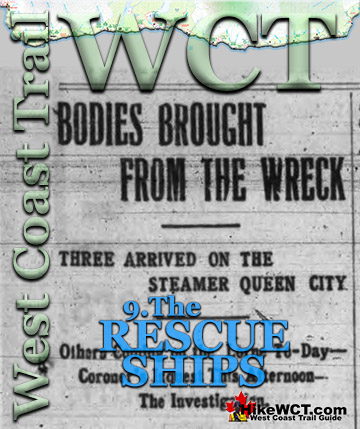
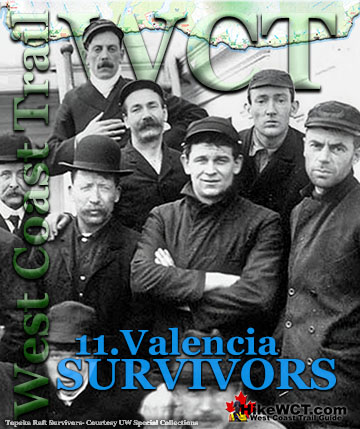
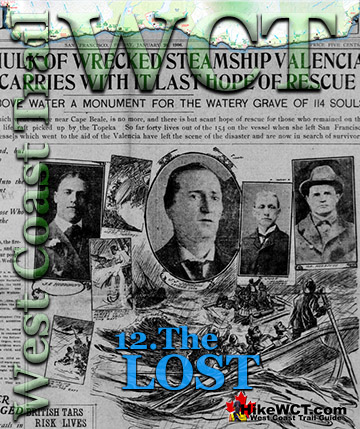
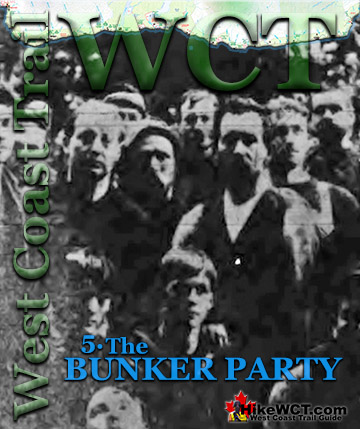
West Coast Trail A to Z
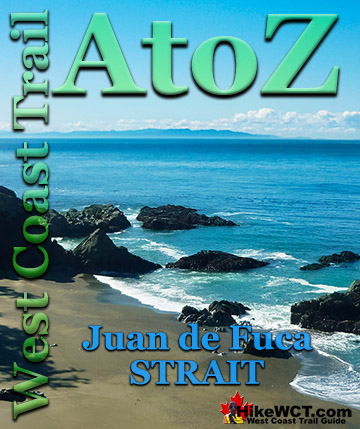
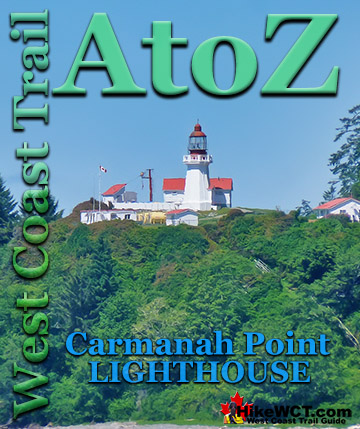

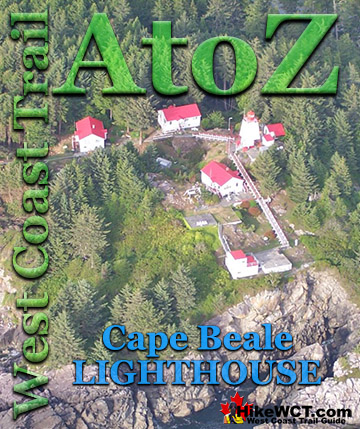
The West Coast Trail by Day
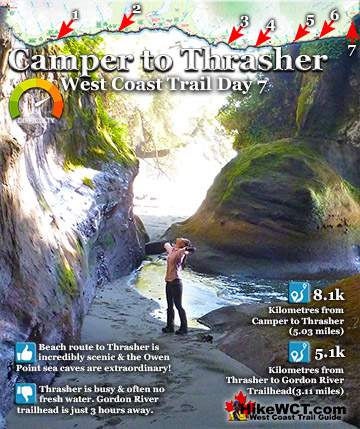
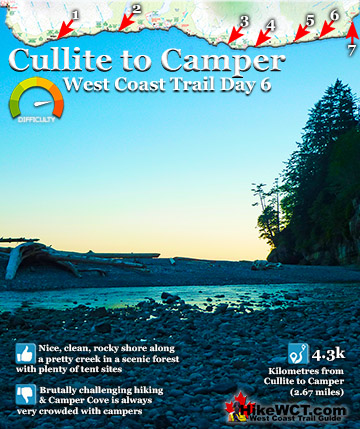
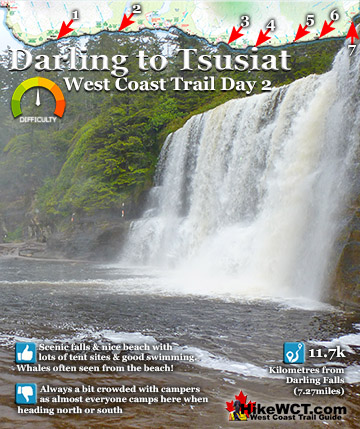
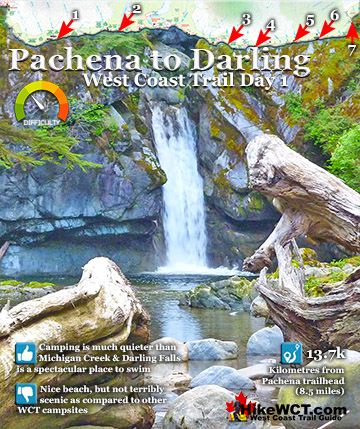
Explore BC Hiking Destinations!

The West Coast Trail

Victoria Hiking Trails

Clayoquot Hiking Trails

Whistler Hiking Trails

Squamish Hiking Trails

Vancouver Hiking Trails

